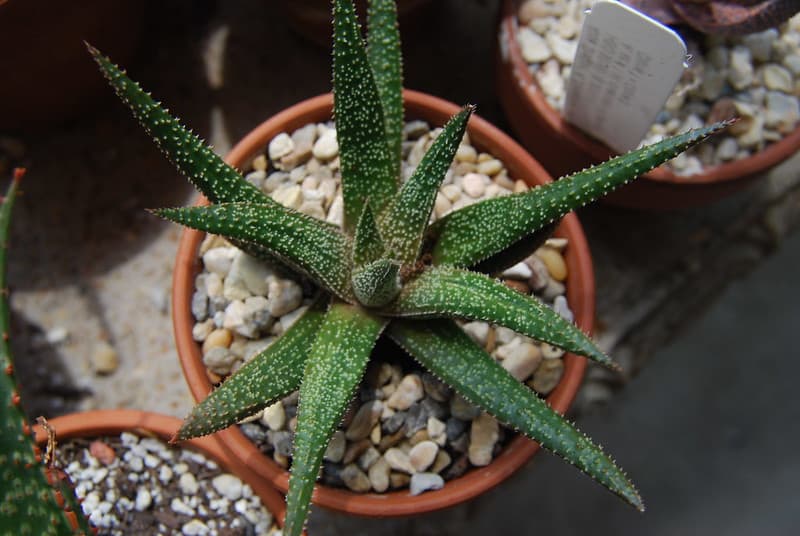Aloe Twilight Zone is as spectacular as the name suggests.
This Aloe hybrid is a dark green covered in small white spots, like stars in a dark sky.
Aloe Twilight Zone is a small variety that is ideal for small pots.
This variety was hybridized by Kelly Griffin who has created many stunning aloes.
With its clump-forming unique foliage, Twilight Zone is perfect as a thriller plant in containers. Not cold hardy.
Attractive, smaller clumping aloe, growing to less than one foot tall.
White spots on dark green leaves appear like stars in a dark sky!
Excellent for massing in water-wise garden beds.
Great accent or small container specimen.
Aloe ‘Twilight Zone’ is a hybrid cross between aloe haworthioides and gasteria carinata, created by kelly griffin, who develops hybrids for altman plants. He named it for the intro to road stallings twilight zone with the floating stars coming at you like driving in a snow storm.
You may like Aloe “Crosby’s Prolific”
Tips to take care of the Aloe Twilight Zone
Illumination
All plants of the genus Aloe need a lot of light to grow healthy and bloom to the fullest.
It is recommended to expose the plants to direct sunlight in the less warm times of the year and move to semi-shade or under filtered light in summer.
The intense summer sun is the main cause of many burns on the leaves of most species.
Temperature
They are plants that appreciate growing in cool or hot climates. Some species survive in environments where daytime temperatures exceed 40 ° C; They are plants of hot climates.
Temperatures below 10 ° C are dangerous for these plants because they encourage the proliferation of fungi in the roots and consequently the rot of these and the plant.
In countries with extreme winters, it is always recommended to grow in vessels to be easily transported to a warmer environment (examples: greenhouses, home interior, etc.).
Substratum
They are mostly quite resistant to growing on a wide variety of substrates but provided they have optimal drainage and good aeration.
2/3 of the universal substrate or garden soil with 1/3 of coarse sand or gravel can be used.
Irrigation Frequency
They are “succulent plants” very well adapted to tolerate extensive droughts, that is, they prefer water scarcity than excess.
They are susceptible to rot if the substrate remains wet for a long time.
It is advisable to water when the substrate has dried completely (usually 1-2 times weekly) if the plant is in the growing season; in a state of latency we must reduce the frequency to biweekly or monthly.
Pruning
These plants are not pruned. Only leaves and flower spikes that have already dried should be removed to prevent them from being attacked by opportunistic pests.
Plant of the genus Aloe with dry leaf that needs to be removed to avoid future pests
Transplant
These plants are usually colonial, forming numerous daughter plants at their base creating groups of many plants in a single area.
In many cases the pots do not support a large number of plants and tend to break (depends on the clear material); It is recommended to transplant when the roots arise through the drainage holes or when the daughter plants protrude from the edge of the pot.
Plagues and diseases
They suffer attacks of mealybugs, aphids, snails, slugs and even birds.
All pests must be eradicated quickly to avoid serious damage to plant health or new pathologies associated with viruses or bacteria transmitted by these same pests.
The main enemies of plants of this genus are fungi; these appear if the humidity is very high and the substrate flooded.
Fungi are the main culprits in the death of many representatives of this group.
Propagation
Very simple from the separation of small children that appear at the base of most species.
To separate these children, a sharp and disinfected object must be used to make the cut.
Then we must let the wound dry for 24 hours and then plant on a sandy and slightly moist substrate.
Seedlings should not be exposed to the sun until they take root.
Multiplication can also be carried out by means of seeds that we must germinate in a substrate made with 2/3 of coarse sand and 1/3 of the universal substrate at 18-24 ° C.
